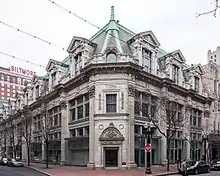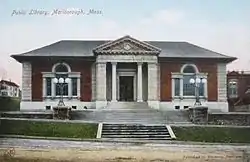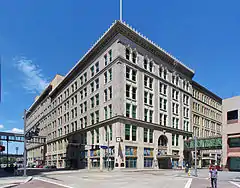Peabody and Stearns
Peabody & Stearns was a premier architectural firm in the Eastern United States in the late 19th century and early 20th century. Based in Boston, Massachusetts, the firm consisted of Robert Swain Peabody (1845–1917) and John Goddard Stearns, Jr. (1843–1917). The firm worked on in a variety of designs but is closely associated with shingle style.[1]

Custom House Tower, Boston
With addition of Pierce P. Furber, presumably as partner, the firm became Peabody, Stearns & Furber.[2][note 1]
Works
Georgia
- Plum Orchard (George L. Carnegie House), Cumberland Island (1898)
- Stafford Place (William Carnegie House), Cumberland Island (1901)
- Greyfeild (Margaret Carnegie Ricketson House, Cumberland Island (1901)[3]
Maine
- York Hall (William D. Sewall House), 1 Edwards St., Bath (1896–98)[4]
- Bangor High School, 185 Harlow St., Bangor (1912)[5]
- Bangor Public Library, 145 Harlow St., Bangor (1912)[5]
- Exchange Building, 27 State St., Bangor (1912–13)[6]
Massachusetts
- Matthews Hall, Harvard University, Cambridge, (1871)
- Frederick L. Ames House, 306 Dartmouth St., Boston (1872)
- College Hall, Smith College, Northampton (1875)[7]
- R. H. White department store, 518–536 Washington Street, Boston (1876)[8]
- Shepherd Brooks House, 275 Grove St., Medford (1881)
- Henry Bradlee Jr. House, Medford (1881–82)
- James C. Bayley House, 16 Fairmont Ave., Newton (1883–84)
- Kragsyde (George N. Black Jr. House), 27 Smith's Point Rd., Manchester-by-the-Sea (1883) - Demolished 1929.
- Elm Court (William D. Sloane House), 310 Old Stockbridge Rd., Lenox (1886)
- Exchange Building, 53 State St., Boston (1887–91)
- Charles E. Cotting Buildings, 186-192 South St., Boston (1891)[9]
- Wheatleigh (Henry H. Cook House), Hawthorne Rd., Stockbridge (1893)
- Fiske Building, 75 State St., Boston (1896) - Demolished 1984.
- Christ Episcopal Church, 750 Main St., Waltham (1897-1902)
- Worcester City Hall, 455 Main St., Worcester (1898)
- Dorchester Heights Monument, Dorchester (1902)
- Marlborough Public Library, 35 W. Main St., Marlborough (1903–04)
- Springfield Fire & Marine Insurance Co. Building, 195 State St., Springfield (1905)
- U. S. Custom House Tower, Boston (1913–15)
Missouri
- St. Louis Museum of Fine Arts, 1815 Locust St., St Louis (1879–81) - Demolished 1919.[10]
- Unitarian Church of the Messiah, 508 N. Garrison Ave., St. Louis (1880–82) - Demolished 1987.[11][12]
- Turner Building, 304 N. 8th St., St. Louis (1882–83) - Demolished 1902.[10]
- St. Louis Club, T.E. Huntley Ave. & Locust Blvd., St. Louis (1884–85) - Demolished.[10]
- George Blackman House, 5843 Bartmer Ave., St. Louis (1885)[13]
- Alvah Mansur House, 3700 Lindell Blvd., St. Louis (1885–86)[14]
- Charles F. Morse House, 200 E. 36th St., Kansas City (1887) - Demolished.[15]
- Henry L. Newman House, 21 Westmoreland Pl., St. Louis (1889) - Demolished.[16]
- Security Building, 319 N. 4th St., St. Louis (1890–92), (Peabody, Stearns & Furber)[10]
- Corinne Dyer House, 38 Westmoreland Pl., St. Louis (1892)[16]
- Edward C. Rowse House, 10 Benton Pl., St. Louis (1892)[17]
- John T. Davis House, 17 Westmoreland Pl., St. Louis (1893–94)[16]
Minnesota
- James J. Hill House, 240 Summit Ave., St. Paul (1887–91) - Peabody & Stearns were fired from the project in 1889.
- Union Depot, 509 W. Michigan Ave., Duluth (1890–92)[18]
New Jersey
- Elberon Casino, Lincoln Ave., Elberon (1882–83) - Demolished.[19]
- Lawrenceville School, Lawrenceville (1884–95)
- Central Railroad of New Jersey Terminal, Jersey City (1888–89)[20]
Pennsylvania
- George W. Childs-Drexel House, 1726 Locust St., Philadelphia (1893)[21]
- Nathaniel Holmes House, Morewood & 5th Aves., Pittsburgh (1895) - Demolished.[22]
- Harvey Childs House, 718 Devonshire St., Pittsburgh (1896)
- Sarah Drexel Fell House, 1801 Walnut St., Philadelphia (1896–98)
- Durbin Horne House, 7418 Penn Ave., Pittsburgh (1897)[23]
- Joseph Horne & Co. Dept. Store, 501 Penn Ave., Pittsburgh (1897–98)[24]
- East Liberty Market, 5900 Baum Blvd., Pittsburgh (1898-1900)[25]
- Remsen V. Messler House, 651 Morewood Ave., Pittsburgh (1900–01)[26]
- Laurento (E. Craig Biddle House), Darby-Paoli Rd., Villanova (1901) - Demolished 1980s.[27]
- Penshurst (Percival Roberts House), Conshohocken State Rd., Lower Merion (1901) - Demolished.[27]
- Krisheim (George Woodward House), 7514 McCallum St., Philadelphia (1910)[28]
- Westview (Livingston L. Biddle House), Westview Rd., Bryn Mawr (1917) - Demolished.[29][27]
Rhode Island

The Providence Journal Building at the corner of Westminster and Eddy Street
- Frederick S. G. D'Hauteville House, 489 Bellevue Ave., Newport (1871) - Burned.[30]
- Nathan Matthews House, 492 Bellevue Ave., Newport (1871–72) - Burned 1881.[31]
- Weetamoe (Nathaniel Thayer House), 2 Rovensky Ave., Newport (1872)[31]
- Grace W. Rives House, 30 Red Cross Ave., Newport (1875–76)[31]
- The Breakers (Pierre Lorillard IV House), 44 Ochre Point Ave., Newport (1877–78) - Burned 1892, later replaced.
- Hillside (Arthur B. Emmons House), 300 Gibbs Ave., Newport (1882)[32]
- Vinland (Catharine Lorillard Wolfe House), Newport (1882–83) - Now Salve Regina's Mcauley Hall.[31]
- Honeysuckle Lodge (Josiah M. Fiske House), 255 Ruggles Ave., Newport (1885–86)[31]
- Midcliff (Caroline Ogden M. Jones House), 229 Ruggles Ave., Newport (1886)[31]
- Pavilion, Easton's Beach, Memorial Blvd., Newport (1887) - Destroyed 1938[33]
- Ocean Lawn (Elizabeth Gammell House), 51 Cliff Ave., Newport (1888–89)[31]
- Rough Point (Frederick W. Vanderbilt House), 680 Bellevue Ave., Newport (1888–91)[31]
.JPG.webp)
Edith Memorial Chapel, Lawrenceville School

Public Library, Marlborough, Massachusetts
- Althorpe (John T. Spencer House), Ruggles Ave., Newport (1889–90) - Now Salve Regina's Founders Hall.[31]
- Episcopal Church of the Messiah, 1680 Westminster St., Providence (1889–90)[34]
- Rockhurst (H. Mortimer Brooks House), Bellevue Ave., Newport (1891) - Demolished 1955.[30]
- Parish House for St. John's Episcopal Church, 275 N. Main St., Providence (1893) - Demolished.[35]
- Shamrock Cliff (G. M. Gaun McRobert Hutton House), 65 Ridge Rd., Newport (1894)[31]
- Beechbound (William F. Burden House), 127 Harrison Ave., Newport (1895)[31]
- Bleak House (Ross R. Winans House), Ocean Ave., Newport (1895) - Demolished 1948.[30]
- Ridgemere (Fannie Foster House), 11 Leroy Ave., Newport (1896)[31]
- Hopedene (Elizabeth H. Gammell Slater House), 43 Cliff Ave., Newport (1899-1902)[31]
- Providence Journal Building, 60 Eddy St., Providence (1906)[34]
Washington, D.C.
- Volta Bureau, 3414 Volta Pl. NW, Washington, D.C. (1893)
Images
 College Hall, Smith College, Northampton, MA, 1875
College Hall, Smith College, Northampton, MA, 1875.JPG.webp) Memorial Hall, The Lawrenceville School
Memorial Hall, The Lawrenceville School Harvey Childs house, now the University of Pittsburgh's Chancellor's Residence
Harvey Childs house, now the University of Pittsburgh's Chancellor's Residence Plum Orchard, built 1898
Plum Orchard, built 1898_-_general_view.jpg.webp) Dorchester Heights Monument
Dorchester Heights Monument The Henry Bradlee Jr. House in Medford, Massachusetts
The Henry Bradlee Jr. House in Medford, Massachusetts
 Bangor Public Library
Bangor Public Library East Liberty Market, built in 1898-1900, and located in the East Liberty neighborhood of Pittsburgh, PA.
East Liberty Market, built in 1898-1900, and located in the East Liberty neighborhood of Pittsburgh, PA. Joseph Horne Company Department Store in Downtown Pittsburgh, Pennsylvania, built in 1900 (with additions in 1923). Architects: Peabody & Stearns, and William S. Fraser.
Joseph Horne Company Department Store in Downtown Pittsburgh, Pennsylvania, built in 1900 (with additions in 1923). Architects: Peabody & Stearns, and William S. Fraser. Christ Church in Waltham, Massachusetts
Christ Church in Waltham, Massachusetts
Notes
- Out of 32 NRHP entries listing "Peabody" and "Stearns" in the NRIS database, just one (Security Building) also includes "Furber".
References
- Bryan, John (16 October 2007). Maine Cottages: Fred L. Savage and the Architecture of Mount Desert. Springer Science & Business Media. p. 42. ISBN 9781568986494.
- Wheaton A. Holden (May 1973). "The Peabody Touch: Peabody and Stearns of Boston, 1870-1917". Journal of the Society of Architectural Historians. 32 (2): 114–131. doi:10.2307/988826. JSTOR 988826.
- Olson, Sarah (1988). Historic Furnishings Report: Plum Orchard, Cumberland Island National Seashore. Harpers Ferry: National Park Service. p. 14.
- Murphy, Kevin D. Colonial Revival Maine. 2004.
- Engineering and Contracting 7 Feb. 1912: 59.
- American Architect 7 Aug. 1912: 14.
- Peabody and Stearns website Archived 2007-02-25 at the Wayback Machine
- Charles Boston (March 30, 2009). "The RH White Company...another giant of old Washington Street!". Shopping Days In Retro Boston. Retrieved January 4, 2017.
- Engineering Record 11 April 1891: 319.
- Mary M. Stiritz (September 21, 1999). "National Register of Historic Places Registration: Security Building" (PDF). Missouri. Retrieved March 2, 2017.
- Unitarian Church of the Messiah NRHP Nomination. 1979.
- "Old Unitarian Church of the Messiah - City Landmark #61". stlouis-mo.gov. St. Louis Cultural Resources Office. Retrieved 14 July 2019.
- American Architect and Building News 18 July 1885: 36.
- American Architect and Building News 5 Sept. 1885: 120.
- "Morse, C.F., Residence". http://digital-libraries.saic.edu/. n.d. Web.
- Hunter, Julius K. Westmoreland and Portland Places: The History and Architecture of America's Premier Private Streets, 1888-1988. 1988.
- Bryan, John Albury. Lafayette Square: St. Louis. 2007.
- Engineering and Building Record 31 May 1890: 415.
- Lewis, Arnold. American Country Houses of the Gilded Age. 1982.
- "The New Depot of the C. R. R. of N. J." Engineering News 6 Oct. 1888: 265.
- Architectural Record July 1896: 61.
- Floyd, Margaret Henderson. Architecture After Richardson: Regionalism before Modernism: Longfellow, Alden, and Harlow in Boston and Pittsburgh. 1994.
- Brickbuilder Nov. 1897: 257.
- Brickbuilder Dec. 1897: 289.
- Toker, Franklin. Buildings of Pittsburgh. 2007.
- Engineering Record 1 Sept. 1900: 215.
- Morrison, William Alan. The Main Line: Country Houses of Philadelphia's Storied Suburb, 1870-1930. 2002.
- Keels, Thomas H. and Elizabeth Farmer Jarvis. Images of America: Chestnut Hill. 2002.
- American Contractor 26 May 1917: 55.
- Miller, Paul F. Lost Newport: Vanished Cottages of the Resort Era. 2008.
- Yarnall, James L. Newport Through its Architecture. 2005.
- "Emmons, Arthur Brewster, Residence". http://digital-libraries.saic.edu/. n.d. Web.
- Newport Historical Society. "History Bytes: Easton's Beach Pavilion". http://www.newporthistory.org/. 19 Feb. 2015. Web.
- Woodward, Wm. McKenzie. Providence: A Citywide Survey of Historic Resources. 1986.
- Brickbuilder April 1894: 60.
Further reading
- Wheaton A. Holden. "The Peabody Touch: Peabody and Stearns of Boston, 1870-1917." Journal of the Society of Architectural Historians, Vol. 32, No. 2 (May, 1973)
External links
| Wikimedia Commons has media related to Peabody and Stearns. |
This article is issued from Wikipedia. The text is licensed under Creative Commons - Attribution - Sharealike. Additional terms may apply for the media files.